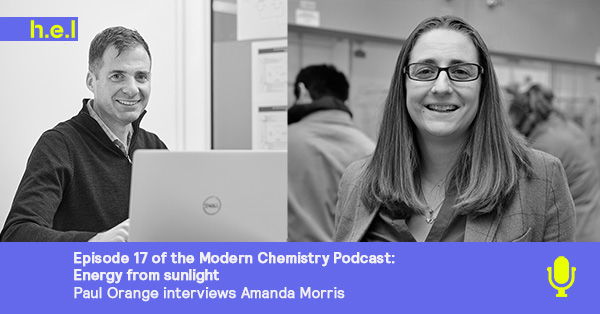Amanda Morris
Energy from sunlight

Episode 17 of the Modern Chemistry podcast features Dr. Amanda Morris, Associate Chair and Professor of Chemistry and the Patricia Caldwell faculty fellow at Virginia Tech. In addition, Amanda is an associate editor of Chemical Physics Reviews, editorial advisory board member for ACS Applied Energy, Materials and Energy Chemistry, as well as being an ACS (American Chemistry Society) expert in sustainable energy.
Our theme music is “Wholesome” by Kevin MacLeod
Music from Film Music
License: CC BY
Connect with me (Paul) on LinkedIn.
Amanda has a BS degree in Chemistry from Penn State University, and PhD in Chemistry from Johns Hopkins University and conducted post-doctoral research at Princeton University prior to her tenure at Virginia Tech.
Amanda’s research focuses on how to convert solar power into usable energy, or fuel, and useful materials or chemicals.
Terms used during interview
- MOFs / Metalo-organic frameworks – Compounds made of metal ions, or clusters, connected to organic ligands, creating specific structures. They are often poruous materials
- Artificial photosynthesis – A human-designed process that creates energy from Co2, water and sunlight, mimicking the same process which occurs naturally in plants.
- Catalysis – Increasing the rate of a chemical reaction by adding a catalyst.
- CO2 – Carbon Dioxide, one of the major greenhouse gases, and one of the molecules used by plants to create energy from photosynthesis.
- Reducing / reduction – the gain of electrons, or a decrease in the oxidation state of an ion (or at specific sites in a molecule).
- Oxidation / oxidizing – the loss of electrons, or an increase in the oxidation state of an ion (or at specific sites in a molecule).
- Redox – A chemical reaction where the oxiadtaion states of atoms are changed. Typically the transfer of electrons leads to oxidation of one chemical component in the reaction, and the reduction of other chemical components.
- Heterogenous surface – A non-uniform surface, which allows different chemical reactions to occur at different points.
- Turnover number – The number of moles of substrate (a measure of the total number of molecules) that a catalyst can convert before becoming inactivated.
- Nano particles – A particle of matter in the range of 1 to 100 nm in diameter.
- Protons – A sub-atomic particle with a positive electric charge of +1e, present in the nucleus of every atom.
- Electron – A sub-atomic particle with a negative electric charge of -1e, which display properties of both particles and waves.
- Solar photons – Particles of light emitted from the Sun.
- Chlorophyll – A word to describe any one of a number of related green pigments found in plants, algae and bacteria. Chlorophyll absorbs energy from sunlight and, along with other molecules, uses that sunlight to provide energy for plant cells, ultimately through the oxidation of water.
- Chromophore – The part of a molecule that is responsible for its color.
If you want to know more information Amanda’s Lab page at Virginia Tech is a great starting point, alternatively you can find her on LinkedIn and Twitter.
Make sure you read our two blogs, ‘Better than the real thing? Lab-based photosynthesis hints at new fuel revolution‘ and ‘Exploring high-pressure catalysis in action‘ that we think you will also find interesting.


